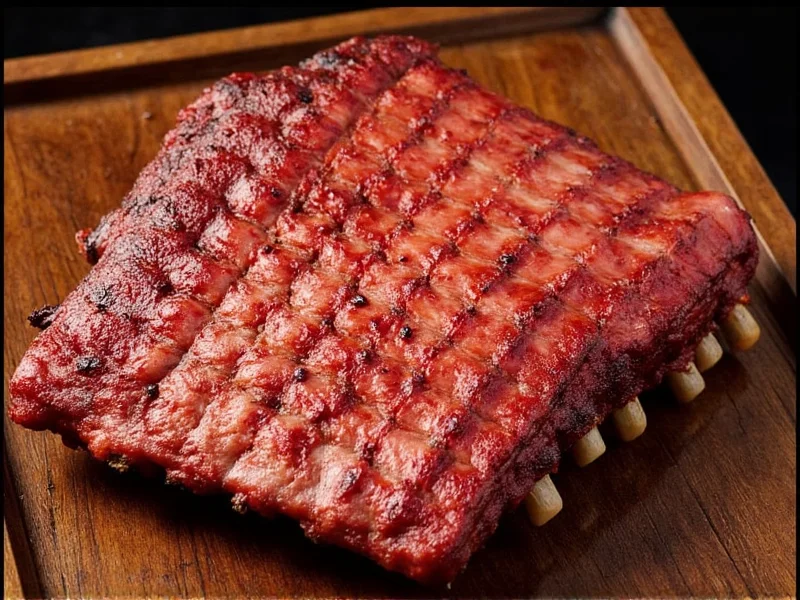When shopping for ribs or planning a barbecue, understanding exactly how many ribs are on a rack of ribs helps ensure you purchase the right amount for your needs. This seemingly simple question has some important nuances that affect cooking, serving sizes, and meal planning.
Understanding Rib Cuts and Count Variations
The number of ribs in a rack isn't as straightforward as it might seem. While 13 is the industry standard for a full rack of pork ribs, several factors influence the actual count you'll find at your grocery store or butcher.
Professional butchers sometimes remove the feathery rib (the smallest, most tapered rib at one end) when preparing racks for retail. This practice explains why you might occasionally encounter racks with only 12 ribs. The specific breed of pig and its size can also affect rib count, with larger hogs potentially yielding racks with 13 or even 14 bones.
| Rib Type | Typical Rib Count | Weight Range | Characteristics |
|---|---|---|---|
| Baby Back Ribs | 11-13 ribs | 1.5-2.5 lbs | Curved, tender, leaner meat |
| Spare Ribs | 11-13 ribs | 2.5-4 lbs | Flatter, meatier, more fat |
| St. Louis Cut | 12-13 ribs | 2-3 lbs | Square-cut spare ribs, trimmed |
| Beef Ribs | 7-8 ribs | 3-5 lbs | Larger bones, more meat |
Why Rib Count Matters for Cooking and Serving
Knowing how many ribs come in a rack directly impacts your meal planning. For standard portion sizes:
- One full rack typically serves 1-2 people as a main course
- Most barbecue restaurants serve half-racks (6-7 ribs) as individual portions
- When buying in bulk for events, calculate 10-12 ribs per adult guest
The variation in rib count becomes particularly important when following recipes that specify "per rack" measurements. A recipe calling for one rack of ribs might yield different results depending on whether you're using a 11-rib or 13-rib rack. For precise cooking, weighing your ribs provides more consistency than counting bones.
How Butchers Prepare Racks of Ribs
The process of preparing ribs for retail significantly affects the final count. Butchers typically:
- Remove the silverskin membrane from the bone side
- Cut between the ribs to separate individual bones
- Trim excess fat and cartilage
- Often remove the feathery rib (the smallest rib)
- Package the remaining bones as a "rack"
This preparation explains why you might see slight variations in rib count even within the same cut type. Some specialty butchers offer "full racks" that include the feathery rib, resulting in 13 bones, while others standardize at 12 for consistency.
Beef Ribs vs. Pork Ribs: Different Count Standards
When exploring how many bones are in a rack of ribs, it's crucial to distinguish between pork and beef varieties. Beef ribs follow different standards:
- Beef short ribs typically come in sets of 3-4 individual ribs per package
- A full beef rib rack contains only 7-8 ribs due to the larger bone size
- Beef back ribs (from the loin area) may have 6-7 bones per rack
This significant difference means you shouldn't apply pork rib counting standards to beef ribs. A "rack" of beef ribs contains far fewer individual bones but substantially more meat per bone.
Practical Tips for Buying Ribs
When purchasing ribs, keep these practical considerations in mind regarding how many ribs make up a rack:
- Ask your butcher about their standard rib count before purchasing
- Weigh ribs rather than counting them for more accurate portioning
- Check if the feathery rib has been removed (affects total count)
- Understand that "family pack" ribs often contain multiple partial racks
- Consider that rib thickness affects meat quantity more than bone count
For competitive barbecue or precise recipe execution, counting the actual ribs in your rack provides better consistency than relying on package labels alone. The visual inspection of your ribs before cooking helps adjust cooking times and temperatures appropriately.











 浙公网安备
33010002000092号
浙公网安备
33010002000092号 浙B2-20120091-4
浙B2-20120091-4